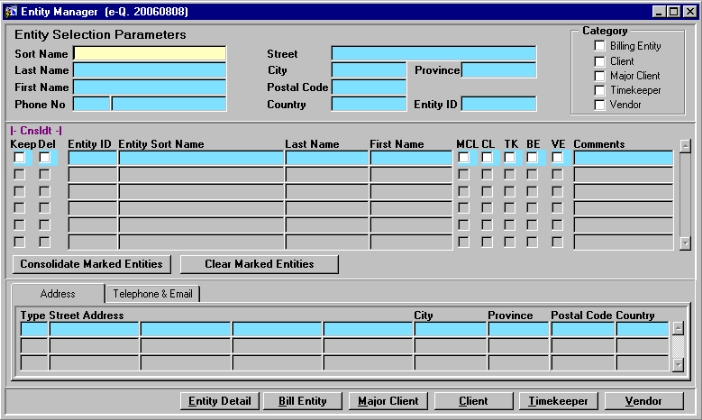Consolidating Multiple Entities
Entity Consolidation is a feature that can only be used by those who have Administrative and/or Accounting privileges in the e-Q system. Entity Consolidation is performed though the Entity Manager screen, and allows the user to "merge" multiple entitles into one.
Follow the menu path:
Maintenance --> Entity --> Entity Manager

Figure 1 - The Entity Manager Screen
- Before a consolidation can occur, the user must first query up the entities that will be involved.
- The user must enter their query restrictions in the Entity Selection Parameters section of the screen, and then press [F8] to execute the query.
- The results will be displayed in the middle section of the screen (Figure2), where the consolidation actually takes place.

Figure 2 - Consolidating the Entities
- From the query results, the user must select the entity into which the other(s) are being consolidated. In other words, the user must select which entity is being "kept"
- To make the selection, the user must 'check' the Keep field for the entity. In Figure 2, Entity 395 is being kept.
- The user must then select the entity (or entities) that are being removed from the system and merged with the entity being kept
- To make the selection(s) the user must 'check' the Del field for the entity (or entities). In Figure 2, Entity 228 is being deleted.
- Once all selections are made, the user must then click the Consolidate Marked Entities button (pressing Save or [F10] will NOT work here)

Figure 3 - Alert
-
The user will be presented with a message, asking if they want to continue with the consolidation.
-
This gives the user a final chance to verify their selections.
-
To continue, click Yes; to cancel the consolidation, click No
Figure 4 - Conformation
- Once the consolidation is complete, the user will be presented with a confirmation message, as seen in Figure 4.

Figure 5 - Requery
-
Once the consolidation is complete, the user will not be able to query up the entity that was deleted.
-
Also, if the user re-queries the entity that was kept, they will be able to see all the information from the other file(s) that was carried over.
-
In the case of the example used here, when entity 395 is re-queried, it is clearly seen that the Client, Timekeeper, and Bill Entity files from entity 228 have been carried over.
-
Note: Should a problem arise with affiliation duplicates, the user can simply delete the unwanted affiliation.